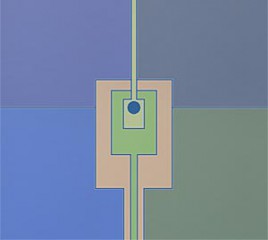Jul 8 2010
Physicists at the National Institute of Standards and Technology (NIST) have demonstrated an ion trap with a built-in optical fiber that collects light emitted by single ions (electrically charged atoms), allowing quantum information stored in the ions to be measured. The advance could simplify quantum computer design and serve as a step toward swapping information between matter and light in future quantum networks.
Described in a forthcoming issue of Physical Review Letters, the new device is a 1-millimeter-square ion trap with a built-in optical fiber. The authors use ions as quantum bits (qubits) to store information in experimental quantum computing, which may someday solve certain problems that are intractable today. An ion can be adjustably positioned 80 to 100 micrometers from an optical fiber, which detects the ion's fluorescence signals indicating the qubit's information content.
 Diagram of a NIST ion trap that incorporates an optical fiber to collect light emitted by the ions (electrically charged atoms).
Diagram of a NIST ion trap that incorporates an optical fiber to collect light emitted by the ions (electrically charged atoms).
"The design is helpful because of the tight coupling between the ion and the fiber, and also because it's small, so you can get a lot of fibers on a chip," says first author Aaron VanDevender, a NIST postdoctoral researcher.
NIST scientists demonstrated the new device using magnesium ions. Light emitted by an ion passes through a hole in an electrode and is collected in the fiber below the electrode surface (see image). By contrast, conventional ion traps use large external lenses typically located 5 centimeters away from the ions—about 500 times farther than the fiber—to collect the fluorescence light. Optical fibers may handle large numbers of ions more easily than the bulky optical systems, because multiple fibers may eventually be attached to a single ion trap.
The fiber method currently captures less light than the lens system but is adequate for detecting quantum information because ions are extremely bright, producing millions of photons (individual particles of light) per second, VanDevender says. The authors expect to boost efficiency by shaping the fiber tip and using anti-reflection coating on surfaces. The new trap design is intended as a prototype for eventually pairing single ions with single photons, to make an interface enabling matter qubits to swap information with photon qubits in a quantum computing and communications network. Photons are used as qubits in quantum communications, the most secure method known for ensuring the privacy of a communications channel. In a quantum network, the information encoded in the "spins" of individual ions could be transferred to, for example, electric field orientations of individual photons for transport to other processing regions of the network.
The research was supported by the Defense Advanced Research Projects Agency, National Security Agency, Office of Naval Research, Intelligence Advanced Research Projects Activity, and Sandia National Laboratories.
Source: http://www.nist.gov/